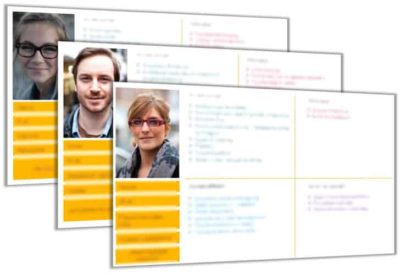 In building a customer-centric business, personas and journey maps are important strategic tools that help provide an in-depth understanding of who your customers are, what they need, and how they interact with your company across all touch points.
In building a customer-centric business, personas and journey maps are important strategic tools that help provide an in-depth understanding of who your customers are, what they need, and how they interact with your company across all touch points.
But more importantly, for sharing customer insights across the organization, these tools can be critical for building buy-in and helping teams take targeted action to improve customer experience.
To get started, you’ll want a clear understanding of what customer personas are, why they’re important, and what makes a good persona. Once you’ve created your personas, you can take a walk in your customers’ shoes with a journey map.
What are personas?
Personas are fictional, yet believable archetypes you can develop to represent your target customers. They go deeper than generalized customer segments by having individual names and stories that reflect personal attributes and behavioral characteristics such as needs, motivations, attitudes, and pain points.
Why are personas important?
Personas have been commonly used to help organizations develop user-centered design. As focus on customer experience has increased in recent years, personas are gaining popularity as a tool to benefit a wide range of departments across an enterprise from sales and customer service to operations and HR.
Personas can help guide customer-centric practices in various ways:
- Develop a deeper understanding of your customers Like Jeff Bezos’ empty chair that represents “the most important person in the room,” personas help you build empathy with your customers. What are their needs and goals? What motivates them? Why do they behave in certain ways?
- Design processes with the customer in mindPersonas help you understand how your customers interact with your company throughout the entire lifecycle. Do your processes reflect the true customer experience, or do they reflect your internal operations? Personas provide awareness of the many journeys your customers may take, so you can improve them.
- Build stakeholder buy-inTo build support for an enterprise-wide customer experience initiative, personas – especially those backed with data and research – can help you describe to executives and stakeholders what a better experience should look like.
Tips for creating highly effective personas
- Align with business objectives to help make your personas powerful tools for teams across the company. Engage key stakeholders to gain diverse perspectives on goals, processes, and issues unique to different lines of business that influence the overall customer experience.
- Use data and research to identify and inform each of your personas. Market segmentation research, surveys, interviews, and social customer insights are all useful methods. This qualitative research can complement your understanding of how customers behave with insight into the “whys,” providing important nuance and detail that humanize your personas.
- Bring your personas to life by crafting engaging, first-person narratives that are realistic representations of your target customers. Give each persona a name and photo to help foster a connection to your actual customers. Include a variety of attributes, such as:
- Demographics: Age, location, education, income, household or family size
- Personal attributes: Their goals, needs, and interests when they interact with your company
- Customer lifecycle: How their needs may vary for different channels and touch points, and how their needs may evolve over time
- Make them eye-catching and memorable with polished, professional quality photos and information layouts for socializing the personas across your organization. The more “real” you can make them, the more your teams can identify with them and map their own actions and attitudes toward delivering the best possible customer experience.
Using personas to map the customer journey
Once you’ve created distinct personas, you can use them to create customer journey maps that describe each persona’s experience at various touch points during their lifecycle with your company. An effective journey map is based on real research and behavior, and should represent the true customer experience– good or bad. That way you build an accurate picture of where you need to make improvements as well as where opportunities exist for cross-sell and up-sell.
Much of the information for creating a journey map will come from your personas (e.g., their goals, motivations, key tasks they want to accomplish, and current pain points), which is why it’s best to create the personas first.
At each step, the journey map should consider factors such as:
- Context – Where is the interaction taking place (e.g., in your store, on the phone, online or mobile, in social media) What is going on around the customer? How might their current context influence how they need to interact and what they want to do?
- Progression – How does each step enable the next?
- Emotion – How does the customer feel at each step? (e.g., are they engaged, bored, or frustrated?)
With a detailed and insightful customer journey map, your business can more effectively assess current and proposed processes, identify targeted actions to resolve pain points, and leverage opportunities for building stronger customer relationships.
The wins from using personas and customer journey maps
Companies can use personas and journey maps to rally employees behind the common goal of improving and optimizing the customer experience. That shared commitment is key to building a customer-centric culture. From there, your organization has the best chance to deliver what your customers want, understand how to exceed their expectations, and create experiences that nurture brand loyalty.
Bottom line? Investing in small powerful tools can translate into very big wins for you and your customers.
Interested to explore customer personas and journey mapping can work for you? Let’s talk!

